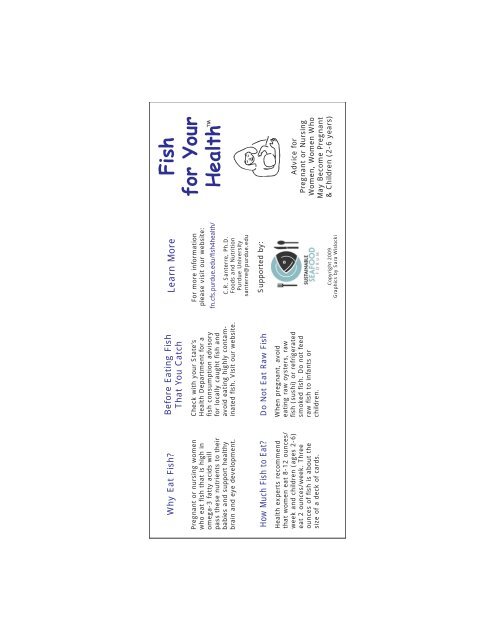You also want an ePaper? Increase the reach of your titles
YUMPU automatically turns print PDFs into web optimized ePapers that Google loves.
Why Eat Fish?<br />
Pregnant or nursing women<br />
who eat fish that is high in<br />
omega-3 fatty acids will<br />
pass these nutrients to their<br />
babies and support healthy<br />
brain and eye development.<br />
How Much Fish to Eat?<br />
Health experts recommend<br />
that women eat 8-12 ounces/<br />
week and children (ages 2-6)<br />
eat 2 ounces/week. Three<br />
ounces of fish is about the<br />
size of a deck of cards.<br />
Before Eating Fish<br />
That You Catch<br />
Check with your State’s<br />
Health Department for a<br />
fish consumption advisory<br />
for locally caught fish and<br />
avoid eating highly contaminated<br />
fish. Visit our website.<br />
Do Not Eat Raw Fish<br />
When pregnant, avoid<br />
eating raw oysters, raw<br />
fish (sushi) or refrigerated<br />
smoked fish. Do not feed<br />
raw fish to infants or<br />
children.<br />
Learn More<br />
For more information<br />
please visit our website:<br />
fn.cfs.purdue.edu/fish4health/<br />
C.R. Santerre, Ph.D.<br />
Foods and Nutrition<br />
Purdue University<br />
santerre@purdue.edu<br />
Supported by:<br />
Copyright 2009<br />
Graphics by Sara Wislocki<br />
Fish<br />
for Your<br />
Health<br />
Advice for<br />
Pregnant or Nursing<br />
Women, Women Who<br />
May Become Pregnant<br />
& Children (2-6 years)
herring<br />
sardines<br />
whitefish<br />
Best Choices<br />
High Mercury / PCB*<br />
Do Not Eat<br />
Lowest Mercury<br />
12 ounces per week<br />
Moderate Mercury<br />
4 ounces per week<br />
bass (striped)*<br />
bluefish*<br />
Chilean sea bass<br />
golden snapper<br />
jack (Amberjack, Crevalle)<br />
king mackerel<br />
marlin<br />
orange roughy<br />
shark<br />
Spanish mackerel (Gulf of Mexico)<br />
swordfish<br />
tilefish (Gulf of Mexico)<br />
tuna (all fresh or frozen)<br />
walleye (Great Lakes)<br />
bass (saltwater, black)<br />
buffalo fish<br />
carp<br />
freshwater perch<br />
grouper<br />
halibut<br />
lobster(northern, Maine, Atlantic)<br />
mahi mahi (Dolphin-fish)<br />
Pompano (Florida)<br />
sablefish<br />
sea trout (weakfish)<br />
snapper<br />
Spanish mackerel (S. Atlantic)<br />
tilefish (Atlantic)<br />
tuna (Albacore, Yellowfin,<br />
White, canned)<br />
white croaker (Pacific)<br />
Rainbow Trout<br />
*PCB (polychlorinated biphenyls) are<br />
higher in these species<br />
catfish (farm raised)<br />
clams<br />
cod<br />
crab<br />
flounder, plaice, sole<br />
haddock<br />
herring<br />
mackerel (Atlantic, jack, chub)<br />
mullet<br />
oysters (cooked)<br />
pollock<br />
rainbow trout (farm raised)<br />
salmon (wild or farm raised)<br />
sardines<br />
scallops<br />
shrimp<br />
squid<br />
tilapia<br />
tuna (Skipjack, Light, canned)<br />
whitefish<br />
mackerel (Atlantic, jack, chub)<br />
rainbow trout (farm raised)<br />
salmon (wild or farm raised)<br />
Eating as little as 6 ounces<br />
per week of these fish<br />
provides the recommended<br />
amount of healthy omega-3<br />
fatty acids.<br />
Advice for Pregnant or Nursing Women & Women Who May Become Pregnant<br />
Excessive mercury can pass through the placenta or mother’s milk and harm your baby. Do not eat fish from the high mercury<br />
category. If you eat 4 ounces from the moderate category, don’t eat any more fish from this category until the next week.<br />
Lowest in Mercury &<br />
Highest in Healthy Fats



